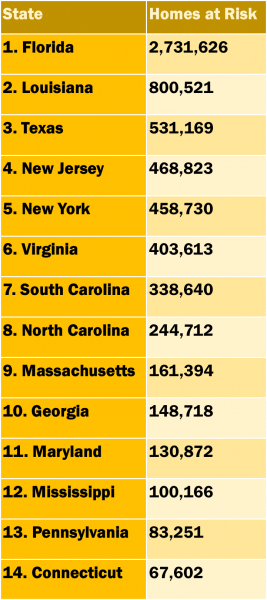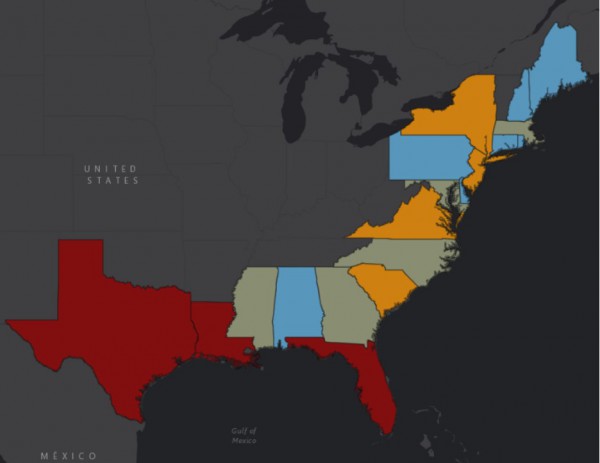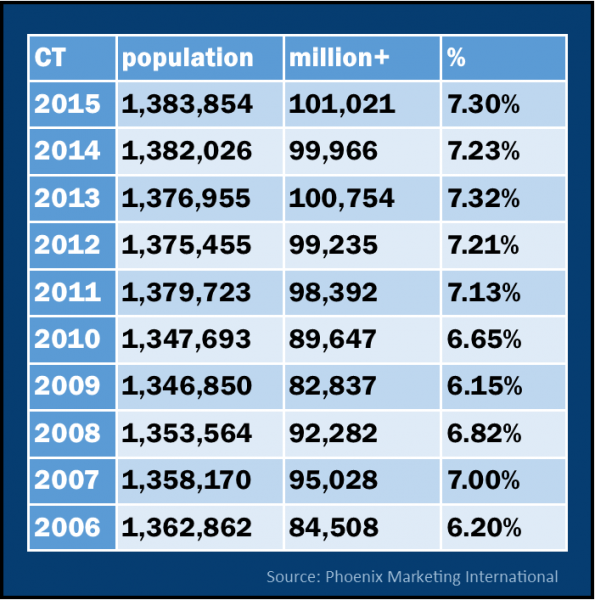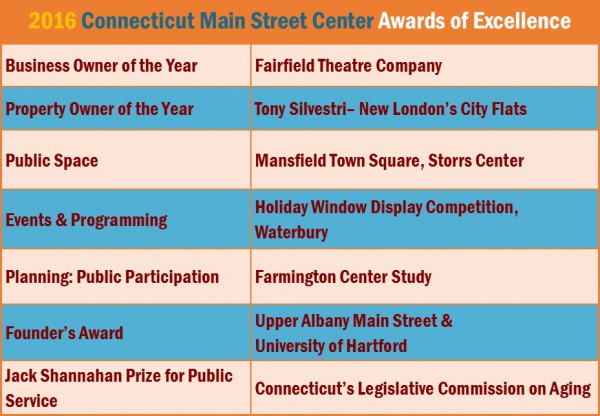67,000 CT Homes At Risk from Hurricane Storm Surges; State Ranks 14th Among States Under Threat
/More than 6.8 million homes on the Atlantic and Gulf coasts are at potential risk of damage from hurricane storm surge inundation with a total reconstruction cost value of more than $1.5 trillion, according to a new analysis by CoreLogic. Connecticut, which has felt the brunt of major east coast storms in recent years, ranks 14th among the states in the potential damage from future storms, with more than 67,000 homes at risk of flood exposure. According to the analysis, nearly 7,000 Connecticut homes are at extreme risk from future storms, another 21,600 homes are at very high risk, and nearly 18,000 are at high risk, depending upon the severity of the storm. In addition, just over 21,000 homes are seen as being of moderate risk. In the analysis, a category 1-5 storm would place a structure at extreme risk, a category 2-5 storm at very high risk, a category 3-5 storm at high risk, and a category 4-5 storm would put a home at moderate risk.
 Among neighboring states, Connecticut ranked behind Massachusetts, New York and New Jersey.
Among neighboring states, Connecticut ranked behind Massachusetts, New York and New Jersey.
In addition to the number of homes at risk, the analysis also provides the reconstruction cost value (RCV), which is the cost to completely rebuild a property in case of damage, including labor and materials by geographic location, assuming a worst-case scenario at 100-percent destruction. The analysis points out that the location of hurricanes that hit land is often a more important factor than the number of storms that may occur during the year.
At the state level, Texas and Florida, which have the longest coastal areas, consistently have more homes at risk than other states. Florida ranks first with 2.7 million at-risk homes across the five risk categories and Texas ranks third with 531,169 at-risk homes. Since the number of homes at risk strongly correlates with the accompanying RCV, these two states rank first and fifth, respectively for having the largest RCV, according to the analysis.
The states with the most at-risk homes are Florida, Louisiana, Texas, New Jersey, New York, Virginia, South Carolina, North Carolina, Massachusetts, Georgia, Maryland, Mississippi, Pennsylvania, Connecticut and Delaware.
Rhode Island, Maine and New Hampshire ranked 17th, 18th and 19th respectively.
The CoreLogic storm surge analysis, officials say, complements Federal Emergency Management Agency (FEMA) flood zone information to provide a snapshot of potential damage exposure at the property level since many properties located outside designated FEMA flood zones are still at risk for storm surge damage. The analysis examines risk from hurricane-driven storm surge for homes along the Atlantic and Gulf coastlines across 19 states and the District of Columbia, as well as for 88 metro areas.
“Using more granular-level data has given us an even clearer picture of which homes are at risk of storm surge damage,” said Dr. Tom Jeffery, senior hazard risk scientist for CoreLogic. “Despite the overall increases in risk, we were glad to see that the number and value of homes in the most extreme, and dangerous, category actually declined.”
At the regional level, the Atlantic Coast has just under 3.9 million homes at risk of storm surge with an RCV of $953 billion, and the Gulf Coast has just over 2.9 million homes at risk with $592 billion in potential exposure to total destruction damage.
When the states are ranked by the anticipated reconstruction cost value of the homes at risk, Connecticut ranks 12th.
Among the nation’s major metropolitan areas, those with the most homes potentially affected by all categories of hurricane are Miami, New York Tampa, New Orleans, Virginia beach, Cape Coral, Houston, Bradenton, Naples, Jacksonville, Philadelphia, Charleston, Boston, Myrtle Beach and Lafayette.
CoreLogic is a leading global property information, analytics and data-enabled services provider. The company’s combined data from public, contributory and proprietary sources includes over 4.5 billion records spanning more than 50 years.
The official hurricane season extends from June-November each year, but hurricanes are not limited to that timeframe. The report indicates that most preseason forecasts to date have predicted an increase in both the total number of storms and the number of hurricanes in 2016, compared with the last three years. The storm predictions from Tropical Storm Risk, for example, show a 35 percent chance of this year being an above average season.


 rs Commission. Replacing them will be the Commission on Women, Children and Seniors and a Commission that merges the Latino, African-American and Asian Pacific American Commissions.
rs Commission. Replacing them will be the Commission on Women, Children and Seniors and a Commission that merges the Latino, African-American and Asian Pacific American Commissions.


 The Latino and Puerto Rican Affairs Commission (LPRAC) was created by an act of the Connecticut General Assembly (CGA) in 1994. This 21 member non-partisan commission is mandated to make recommendations to the CGA and the Governor for new or enhanced policies that will foster progress in achieving health, safety, educational success, economic self-sufficiency, and end discrimination in Connecticut. As of 2014, the state’s Hispanic population exceeded 500,000, about 15 percent of the state’s overall population.
The Latino and Puerto Rican Affairs Commission (LPRAC) was created by an act of the Connecticut General Assembly (CGA) in 1994. This 21 member non-partisan commission is mandated to make recommendations to the CGA and the Governor for new or enhanced policies that will foster progress in achieving health, safety, educational success, economic self-sufficiency, and end discrimination in Connecticut. As of 2014, the state’s Hispanic population exceeded 500,000, about 15 percent of the state’s overall population. ”
” “This is an effort to reassert Connecticut as one of the strongest economies in the nation and in the world,” State Representative William Tong recently told WNPR. He's co-chair of the state’s
“This is an effort to reassert Connecticut as one of the strongest economies in the nation and in the world,” State Representative William Tong recently told WNPR. He's co-chair of the state’s 


 Why does USA Gymnastics keep coming back? “Everything runs smoothly,” suggests Mikulak, expressing a competitor’s viewpoint. “They trust us,” adds Murdock, noting that when Connecticut bids to attract future national caliber sporting events, the first question asked is “what else have you hosted.”
Why does USA Gymnastics keep coming back? “Everything runs smoothly,” suggests Mikulak, expressing a competitor’s viewpoint. “They trust us,” adds Murdock, noting that when Connecticut bids to attract future national caliber sporting events, the first question asked is “what else have you hosted.”



 tion into one composite indicator of entrepreneurial business growth.”
tion into one composite indicator of entrepreneurial business growth.”
 The quarterly survey is released by
The quarterly survey is released by 





 Already, 2.9 million freelancers earned more than $100,000 last year, up from 2 million who hit the six-figure mark just four years earlier, according to MBO Partners. The report indicated that 60 percent of freelancers surveyed said they started freelancing by choice—up from 53 percent last year—and 67percent of freelancers agree that more people are choosing to work independently today compared to three years ago.
Already, 2.9 million freelancers earned more than $100,000 last year, up from 2 million who hit the six-figure mark just four years earlier, according to MBO Partners. The report indicated that 60 percent of freelancers surveyed said they started freelancing by choice—up from 53 percent last year—and 67percent of freelancers agree that more people are choosing to work independently today compared to three years ago.
 He added, “We advised him that there are ways to be close to family and friends in Connecticut on occasion that are perfectly legal. We're trying to send a more welcoming message to the high earners as a group." Homeowners who spend more than 183 days in the state are considered residents for tax purposes.
He added, “We advised him that there are ways to be close to family and friends in Connecticut on occasion that are perfectly legal. We're trying to send a more welcoming message to the high earners as a group." Homeowners who spend more than 183 days in the state are considered residents for tax purposes. wealthiest individuals, had relocated from Greenwich to Florida, the second individual in that tax bracket to do so recently. The exits, the Courant reported, “leave Connecticut with 13 billionaires, including Ray Dalio ($15.6 billion) and Steven Cohen ($12.7 billion), both hedge fund owners who live in Greenwich.” Eight of those 13 state residents list Greenwich as their home address, according to
wealthiest individuals, had relocated from Greenwich to Florida, the second individual in that tax bracket to do so recently. The exits, the Courant reported, “leave Connecticut with 13 billionaires, including Ray Dalio ($15.6 billion) and Steven Cohen ($12.7 billion), both hedge fund owners who live in Greenwich.” Eight of those 13 state residents list Greenwich as their home address, according to 






























